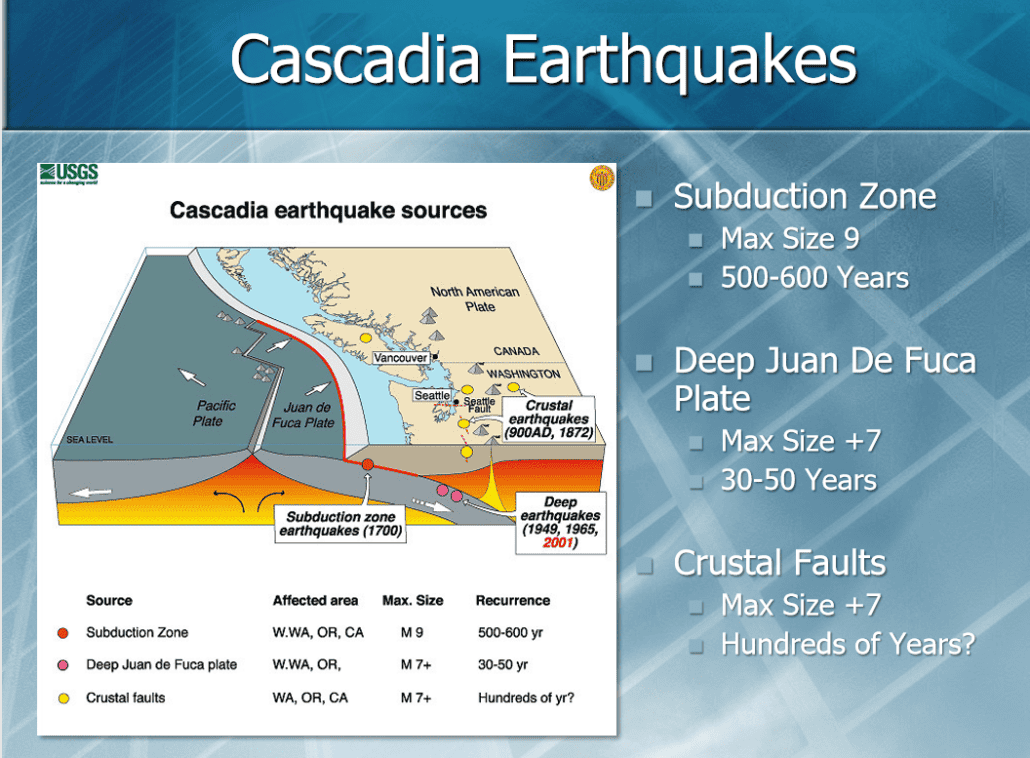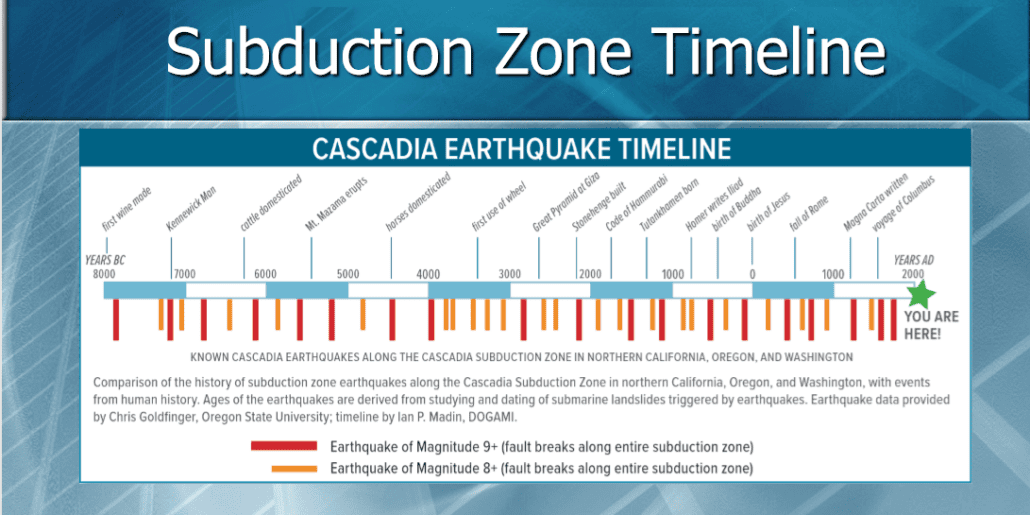Introduction to Emergency Preparedness at RVM
(updated 9/08/21)
Prepare!…Why?…for What?
 The Rogue Valley is a great place to live – beautiful scenery, recreational opportunities cultural activities, good medical care – but like everywhere else, it has its share of hazards. Jackson County evaluates the risks and hazards as shown in table PS-1.
The Rogue Valley is a great place to live – beautiful scenery, recreational opportunities cultural activities, good medical care – but like everywhere else, it has its share of hazards. Jackson County evaluates the risks and hazards as shown in table PS-1.
In spite of already having experienced Disaster no. 2 in the form of the coronavirus pandemic, and Disaster no. 3 as the Almeda Fire evacuation of 2020, we will start with item no. 1 – the Cascadia Earthquake. Not only is it the biggest threat all by itself, but it is also a cause of other listed threats – earthquakes start fires, cause landslides and floods, and set the stage for epidemics. Many of the effects of the natural hazards discussed are similar to the results of human accidents, war, terrorism, or civil unrest. To be prepared for a big earthquake is to be prepared for just about anything. And the Cascadia subduction zone (illustrated in the figure above) is nothing if not the source of big – or very big – or extremely big earthquakes. The subduction zone is an area along the coast of the Pacific NW, where the earth’s crust at the bottom of the Pacific Ocean is being forced under the crust supporting continental North America. That takes a lot of energy and crustal plates are sticky things, so when they hang up and then release…BANG! A big earthquake.

Or actually, BANGBANGBANG, because this isn’t your local California earthquake. This will inflict heavy to moderate damage on an area of close to 100,000 square mile that contains 12 million people. It will be M 8-9.2 at the source and 6-7 in the interior valley—and it will go on for 2-4 minutes. For comparison, the Loma Prieta earthquake in 1989 that damaged the Monterey and San Francisco Bay areas was M 6.9, and lasted 15 seconds.
Medford is on the eastern edge of the geographic region expected to have “moderate” damage. However, all of the access routes, including the I-5 corridor, cross mountainous terrain, where bridge and highway collapse, landslides, and treefalls (aided by winter storms or summer wildfires) are likely to isolate the Rogue Valley. And although our location may not be as devastated as the coast (tsunami) or Portland and the Willamette Valley (built on sediment), that means that we are not likely to have the highest priority for relief efforts.
The State of Oregon has evaluated probable earthquake impacts and produced some estimates of recovery times. As can be seen from the box below, survivors would face weeks to months without most of the physical, social and economic infrastructure that supports our normal lives. Further, experience with hurricanes, floods, and wildfires shows us that rescue and relief efforts may take days to get organized and start operating effectively – even when there has been advance warning. We should expect to be completely reliant on ourselves and our immediate neighbors for several days to a week or more.
Estimated* Recovery Times,Valley Locations
*(State of Oregon)Electricity 1-3 months
Water 1-12 months
Sewers 1-12 months
Highways 6-12 months (partial)
Medical Facilities 18 months
Police/Fire stations 2-4 months
The Cascadia is worthy of preparation – but how likely is it? As it turns out, geologists have been busily reconstructing the history of earthquakes in the Pacific NW, with the results shown in the figure below. On average, something happens every 300-350 years, and the last one was in 1700 – 320 years ago. Estimates are that in the next 50 years, the chances of a great earthquake affecting Northern California to Southern British Columbia is 17%, and the chance of a large earthquake affecting Southern Oregon and Northern California is 37%.

.
Some people argue that they don’t expect to live long enough to worry about that. Possibly true, but living out your waning days as a refugee in the aftermath of a mega-earthquake is probably not the ideal end of life that most of us would envision. There is a saying among emergency managers: “The difference between an emergency and a disaster is that in an emergency, you can call 911 and somebody will come.” That unquestionably puts the Cascadia earthquake squarely in the disaster category. What is questionable is how well we will do at insuring that we will be in the disaster survivor category.
Prepare — How?
At RVM: Of the 900-1000 residents, a substantial number are dependent on others, and of those considered “independent,” many have limitations such that minimally looking after themselves is the most that could be hoped for in an earthquake disaster. Even the most robust of us are physically and mentally well past the prime of life. As a community, we may have more education and experience than most, but we are certainly not the “average” for which most of the emergency preparedness instructions are written. In particular, we have a much higher proportion of vulnerable people, and fewer potential rescuers or caregivers.
RVM employees are a skilled and dedicated group, and many are trained in emergency and disaster operations. The administration has arranged for some backup stocks of food, water, and other supplies, plus emergency generators, fuel, and equipment. However, none of these can supply anything close to normal functioning, can be counted on to last more than 2 weeks without replenishment, or can be guaranteed to escape damage in an earthquake. Staff availability is even more critical. Many employees have homes and families to look after or live far from RVM, and depending on the time and severity of the disaster, there could be fewer than a dozen generally available staff members on campus at the time of the event to deal with a damaged physical plant and up to 1000 residents.
Responses: There are two basic responses in case of an emergency or a disaster – stay where you are (shelter in place) or go away (evacuate). We have to be prepared for either one; in the case of a nearby or rapidly advancing fire, prompt evacuation is essential. On the other hand, if there is widespread earthquake damage but most of the RVM buildings and cottages remain habitable, “shelter in place” is the safest decision. If we “shelter in place” we can probably continue to live in our (damaged) homes with our possessions, but without electricity, heat, running water, or any other municipal services. In this case, our possessions need to include some things that we don’t normally think about.
On the other hand, if we evacuate we need to be able to take with us at least a few items that may be essential to either immediate survival or longer term recovery – and we need to be able to do it quickly. In either case, we have to recognize important differences – between the able-bodied and vulnerable or handicapped, and between cottage and high-rise residents.
.
Steps to Earthquake Preparedness: Step 1 is to abandon any assumptions about being taken care of quickly and completely by RVM staff. If there is emergency power to the kitchen and enough Dining Services people can reach RVM and remain permanently on site, then RVM may be able serve meals for a couple of weeks – at one location, with no delivery or transport. If there are enough workers available, it may be possible to organize a sanitation patrol that picks up plastic bags of everything you can’t flush down the toilet any more, and takes them away to bury somewhere else. But it’s pretty clear that if we assume those things will happen, and they don’t, life will be very, very miserable.
Step 2 is to work through the following list, using the more specific information provided by the following pages and the links below.
- Neighbors – get to know them, and make plans for mutual aid.
- Drinking water – recommended, a gallon per person per day for two weeks, and don’t forget Fido or Fluffy. If you don’t have room, get as much as you can fit in.
- Food, and a plan to be sure it’s edible when needed. Up to two weeks worth is ideal.
- Light sources (and spare batteries).
- Warmth – bedding, clothes, sleeping bag.
- Sanitation – plastic bags, TP, bleach, toiletries. Medicines for an extra month.
- Prepare a “go-bag” for each person to take basic essentials in a quick evacuation.
Sound challenging? The following documents and links provide additional information, detailed lists of items and sources, and procedures for disaster preparation and response.
LINKS
The earthquake experience, description and preparation
https://www.oregon.gov/OEM/hazardsprep/Pages/Preparedness-Publications.aspxv
Cascadia minimum supplies– suggested preparation supplies (below, end of section)
https://theprepared.com/– a thorough, balanced, well researched Preparations Website.


First time I tried this feature. It works well.